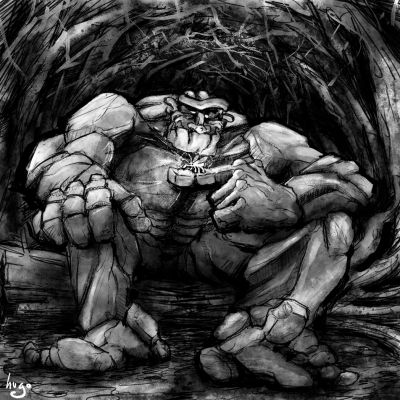Gardeners

Petra Viventem, a.k.a. Endolith, Golem
This section touches on the race of ‘’Petra Viventem’’, the Gardeners of Lume. The god-likeDeumana manipulated the terrain as much as they tampered with living creatures, and the resulting topography needed to be maintained while they saw to other projects. Their answer to this strenuous groundskeeping was to a create silicon-based, horticulturally-inclined race; beings that were immensely strong, durable, and obedient; at least at first. These Gardeners, who refer to themselves as Endoliths (a name which never caught on outside their kin), were the first of the new Races to achieve emancipation from their masters. Well before the scholarly Slenders joined with the Frost Giants in their insurrection, the Gardeners were traversing the Continent, encouraging autonomy amongst their kin, and establishing a well-placed network that would become crucial during the events of the Schism.
The Gardeners have an intrinsic connection to the land, its Flora and fauna, and were installed to maintain the complex and diverse ecosystems created by the Deumana. Endowed with more intelligence than other Races at inception, they quickly formed bonds with their naive, servile charges. The Deumana, in their indifference, saw this development too late, only dawning on them to dismantle their former servants as the rebellion broke out in force. By happenstance the Endoliths had been unwisely posted by the Deumana at key locations; subsequently, their part in the Schism rocked the foundations of the Deumana empire.
At the time of the Schism the Gardeners numbered in the tens of thousands, sufficient numbers to each oversee a manageable tract of land. Immortal but not invulnerable, it is estimated that only a few hundred have survived the rigorous cycles. As they were created sterile, it is only a matter of time until their numbers fade from existence, though they leave a great legacy in the form of their tutorage of the Folk and other Races. See the entry on Philosophy and governance on Lume for more about Endolithic society.
Gardeners vary significantly in size and silhouette; no two are identical, all are asymmetrical, and are endowed with an arrayed assortment of limbs. A gardener for every occasion. Gangly gardeners for ranging the sloping plains, many-handed ones for scaling cliff-sides, even small ones, to reach where others cannot. Their silicon foundation is derived from their area of origin; while one may be primarily granite, another may consist mostly of sandstone. It is theorized by some Slender academics that Enodliths contain rare minerals to facilitate their function. Happily, none have made much progress in confirming this theory.
Gardeners have close diplomatic relations with the Slenders, due in part to their respect for the latters’ academic inclination, and frequently aid the mild scholars in their geographical studies. It is commonly believed the Gardeners first woke the Slenders from their servitude, bringing them into the fold of the rebellion; both Races are quiet on the subject. The Gardeners also retain strong ties with the reclusive Frost Giants, exchanging information with these ascetics with whom they have much in common. They take an interest in things great and small. For example, on their rounds a resident guardian may check in on a small family of blippets, attend to the growth of an ancient tree, and monitor the slow wear of a hill, considering all to be of equal merit. Strongly empathetic, they nonetheless accept the impartiality of the universe, having adopted a predominantly stoic worldview thanks to their scholarly comrades.
Many of the Continent’s villages and hermits boast a Gardener patron, though their disparate lifespans can create rifts in their associations. Provincial custodians of the regions they were charged with cycles ago, they tolerate occupation of said area by the innocuous, often teaching Folk permaculture, horticulture, philosophy and other subjects in which they take an interest. Gardeners prefer not to interfere unless asked, and even then are discriminate about doing so. Communities considered to be destructive are politely but firmly dissuaded from their habits; erudite slabs of rock being on the whole very persuasive. This tendency has likely prevented many an empire from forming prematurely. The case of the empire of Multis, spearheaded by Necrosis, is a notable exception; it would be worth investigating the circumstances of resident Endoliths.
Outside the Folk they alone can observe the phenomenon known to Casters as Anima, but unlike the neo sapiens, they cannot influence these elements. To this end these sentient elementals instead make use of their immense bulk and inexhaustible stamina, diverting rivers or flattening hills with their spade-like hands. It is fortunate for Lume’s inhabitants that this race does not crave power, and opts for a simpler existence.
Gardeners are conscious of their size and mass; when they wander their terrain, as is their wont, they make no secret of their movements. The stomping gives a creature plenty of time to be anywhere but underfoot.
